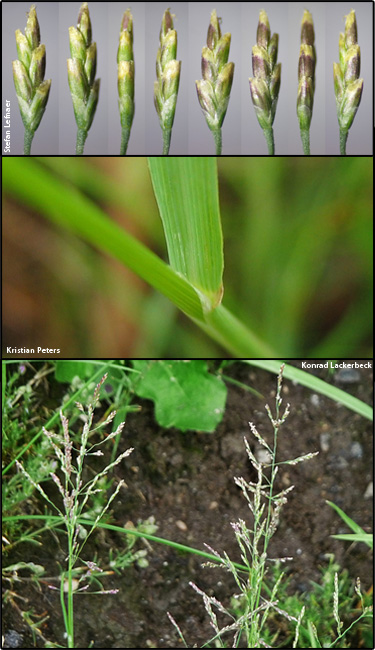Weeping alkaligrass (Puccinellia distans)
 Synonyms: Poa distans, Puccinellia distans var. tenuis, Puccinellia retroflexa, Puccinellia suksdorfii, Glyceria distans, Glyceria pulvinata, Sclerochloa distans
Synonyms: Poa distans, Puccinellia distans var. tenuis, Puccinellia retroflexa, Puccinellia suksdorfii, Glyceria distans, Glyceria pulvinata, Sclerochloa distansCommon Names: Reflexed salt grass, slender alkali grass
Description: First introduced to the United States in New York in 1893.
Habit: Tufted perennial, tall, hollow, glabrous to slighty rough branches.
Leaves: Basal, 2-4 alernate leaves, 4 in. long and 1-4 mm wide, hairless, rough, flat or rolled edges. Ligules are blunt, smooth and 1 mm long.
Stems: Hairless, unbranched, erect, clump forming.
Flowers: Spikelets containing 5-6 flowers, 1-8 in. long, erect or nodding, purplish in color, oblong to lance-elliptic. Bloom from June to August.
Fruit and seeds: Elliptic, brown in color, 1.5 mm long.
Habitat: Native to Eurasia. Can be found in salt flats and along lakeshores. Salt-tolerant.
Reproduction: By seed.
Similar species: Seaside alkaligrass (Puccinellia maritima), Nuttall's alkaligrass (Puccinellia nuttalliana), which is usually taller. Tufted lovegrass (Eragrostis pectinacea), which has long hairs on the sheaths.
Monitoring and rapid response: Reducing salt contamination in freshwater may help management efforts. Credits: The information provided in this factsheet was gathered from the Great Lakes Aquatic Nonindigenous Species Information System (GLANSIS).
Individual species images that appear with a number in a black box are courtesy of the Bugwood.org network (http://www.invasive.org). Individual photo author credits may not be included due to the small display size of the images and subsequent difficulty of reading the provided text. All other images appear courtesy of Google (http://images.google.com).
